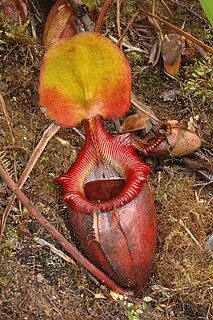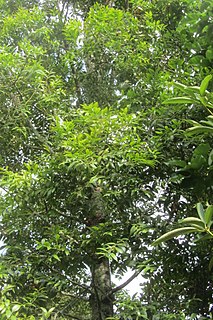Related Research Articles

Hypsicalotes is a genus of the family Agamidae having a single species Hypsicalotes kinabaluensis found in Malaysia.

Nepenthes villosa, or the villose pitcher-plant, is a tropical pitcher plant endemic to Mount Kinabalu and neighbouring Mount Tambuyukon in northeastern Borneo. It grows at higher elevations than any other Bornean Nepenthes species, occurring at elevations of over 3,200 m (10,500 ft). Nepenthes villosa is characterised by its highly developed and intricate peristome, which distinguishes it from the closely related N. edwardsiana and N. macrophylla.

Nepenthes × kinabaluensis, or the Kinabalu Pitcher-Plant, is the natural hybrid between N. rajah and N. villosa. It was first collected near Kambarangoh on Mount Kinabalu, Borneo by Lilian Gibbs in 1910 and later mentioned by John Muirhead Macfarlane as "Nepenthes sp." in 1914. Although Macfarlane did not formally name the plant, he noted that "[a]ll available morphological details suggest that this is a hybrid between N. villosa and N. rajah". It was finally described in 1976 by Shigeo Kurata as N. × kinabaluensis. The name was first published in Nepenthes of Mount Kinabalu, but was a nomen nudum at the time as it lacked an adequate description and information on the type specimen. The name was subsequently published validly by Kurata in 1984.
The Kolopis River is one of the major rivers that flows through Kinabalu National Park in Sabah, Malaysia. An area adjacent to the upper Kolopis River is home to a number of pitcher plants of the genus Nepenthes, including N. edwardsiana, N. rajah, and N. villosa, as well as two natural hybrids involving these species.

Agathis kinabaluensis is a tree of Borneo in the conifer family Araucariaceae. The specific epithet kinabaluensis is from the Latin, referring to the species being native to Mount Kinabalu in Sabah.
Dacrycarpus kinabaluensis is a species of shrubby conifer in the family Podocarpaceae. It is found only on Mount Kinabalu in Sabah, Malaysian Borneo.
The mountain serpent eagle, also known as the Kinabalu serpent eagle, is a bird of prey that is found in northern Borneo. It is found at altitudes of 1,000–4,100 metres (3,300–13,500 ft) in forest, especially where it becomes stunted. Where their range overlaps, the crested serpent eagle generally occurs at lower altitudes. The mountain serpent eagle is darker than the Bornean subspecies of the crested serpent eagle.
Meristogenys kinabaluensis is a species of frog in the family Ranidae. It is endemic to Borneo and is found in Sabah, Sarawak (Malaysia), and Kalimantan (Indonesia). The specific name refers to its type locality, Mount Kinabalu.

The Bornean leafbird, also known as the Kinabalu leafbird, is a species of bird in the family Chloropseidae. It is found in humid forest in Borneo, to which it is endemic. It has traditionally been considered a subspecies of the blue-winged leafbird, but differ in measurements and morphology, the female Borneon leafbird having a distinctive male-like plumage. The distribution of the two are known to approach each other, but there is no evidence of intergradation.

Prunus kinabaluensis is a species of plant in the family Rosaceae. It is found in Malaysia and the Philippines.

Asota kinabaluensis is a species of noctuoid moth in the family Erebidae first described by Walter Rothschild in 1896. It appears to have no close relatives in the genus Asota.
Entomophobia is a genus of flowering plants from the orchid family, Orchidaceae. Only one species is known, Entomophobia kinabaluensis, endemic to the Island of Borneo. The epithet "kinabaluensis" refers to Mount Kinabalu in Sabah.
Chionanthus kinabaluensis is a tree in the family Oleaceae.
Groenendaelia is a monotypic moth genus in the family Cossidae. Its only species, Groenendaelia kinabaluensis, is found in Sundaland, including Borneo. The habitat consists of montane forests and lowland areas.

Pterolophia is a genus of longhorn beetles of the subfamily Lamiinae, containing the following species:
Pterolophia instabilis is a species of beetle in the family Cerambycidae. It was described by Per Olof Christopher Aurivillius in 1922. It is known from Seychelles.
Pterolophia guineensis is a species of beetle in the family Cerambycidae. It was described by James Thomson in 1864, originally under the genus Alyattes.
Durio kinabaluensis, known as mountain durian, is a tree in the genus Durio found on the Crocker Range and Mount Kinabalu in Sabah.

Tenompok Forest Reserve is a protected forest reserve in Ranau District of West Coast Division, Sabah, Malaysia. It was designated as a Class 1 Forest Reserve by the Sabah Forestry Department in 1984. Its area is 1,984 hectares (19.84 km2). A former reserve, the Kampung Bundu Tuhan Native Residence Reserve, occupied what is now the eastern portion of Tenompok. The reserve is mountainous, reaching 1,660 metres (5,450 ft) above sea level. Vegetation consists of lower montane forest and montane kerangas forest. Both share a similar species composition, although trees in montane keranga forests are smaller. The reserve's Tomis River is a tributary of the Tuaran River. The area of the reserve has never received significant logging, aside from small amount near what are now its borders. This small logging is thought to be carried out by nearby villages for local use. There is also some agricultural encroachment. The reserve lies between Kinabalu Park and Crocker Range National Park. One farmer has a house within the reserve. There are several settlements around the reserve, along with agricultural land.
References
- ↑ BioLib.cz - Pterolophia kinabaluensis. Retrieved on 8 September 2014.